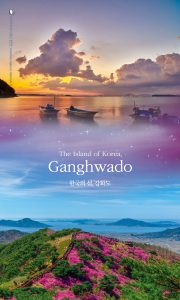 Ganghwado is an island on the western mouth of the Han River, which flows through the heart of Seoul, the South Korean capital. With a total area of 302.58㎢, it is the fourth largest island in Korea.
Ganghwado is an island on the western mouth of the Han River, which flows through the heart of Seoul, the South Korean capital. With a total area of 302.58㎢, it is the fourth largest island in Korea.
Due to location at the mouth of the Han River and its proximity to Goryeo’s (918 – 1392) capital Gaeseong and Joseon’s (1392 – 1910) capital Hanyang (today’s Seoul), it bore witness to many historical events. Faced with Mongolian invasion, Goryeo moved its capital temporarily to Ganghwado where it made the Goryeo Daejanggyeong, part of UNESCO’s Memory of the World Register. During Joseon, Ganghwado served as a military stronghold where many military facilities were built.
Ganghwado also boasts many Bronze-Age relics and artifacts. Most significant are the Goindols or dolmens. Part of the ancient Megalithic culture, dolmens are found across the world, but they are largely concentrated in Northeast Asia, including Korea, China, and Japan. Korea has the largest concentration of various types of dolmens in the world. Roughly 120 dolmens, including the cluster in Bugeun-ri, are found on Ganghwado. The Bugeun-ri Goindol is a table-type dolmen that is made of two 2.6-meter high upright stones supporting a massive 7.1-meter long and 5.6-meter wide capstone. Along with Gochang and Hwasun dolmen sites, the Ganghwa dolmen sites were designated as a UNESCO World Heritage Site in 2000.
From prehistoric times, Goguryeo (37 BC-AD 668), Baekje(18 BC-AD 660), Silla(57 BC-AD 935), Goryeo(918-1392), Joseon(1392-1910), to the present, Ganghwado has been an important part of Korea’s 5,000 years of history.